From Trends to Insights: A Text Mining Analysis of Solar Energy Forecasting (2017–2023)
Abstract
1. Introduction
2. Research Objectives and Methodological Framework
2.1. Research Objectives
- Objective 1: ref. [6] identified the leading journals, authors, organizations, and countries in solar energy forecasting research from 2012 to 2017. The objective aims to update that analysis by identifying the current leaders in this field from 2017 to 2023, inclusive, thereby capturing the latest trends and shifts in scholarly influence and contributions.
- Objective 2: ref. [6] also listed and elucidated the most commonly used abbreviations in solar energy forecasting within the 2012 to 2017 period. The aim is to ascertain whether new abbreviations have emerged since then, reflecting evolving terminologies and advancements in the field.
- Objective 3: ref. [7] examined select companies specializing in solar energy forecasting. This study aims to expand that analysis to gain a more comprehensive understanding of these firms. By engaging with these companies and conducting research on them, the goal is to enhance the synergy between the academic community and the industry, fostering collaborative efforts and practical applications of research findings.
2.2. Dataset Selection for Text Mining
2.3. Dataset Extraction and Processing for Text Mining
2.3.1. Metadata Extraction and Processing
2.3.2. Full-Text Extraction and Processing
3. Findings from Data Mining: Analysis of Publication Infrastructure
3.1. Prominent Journals
3.2. Prominent Authors
3.3. Prominent Affiliations and Countries
4. Findings from Data Mining: Analysis of Abbreviations and Technical Discussion
4.1. Output Variables in Solar Energy Forecasting
4.2. Solar Energy Forecasting Output Formats
4.3. Solar Forecasting Methods
4.3.1. Classification Based on Type of Data Sources
- Satellite and Sky Imageries:
- Numerical Weather Predictions:
- On-site Historical Time Series Data:
4.3.2. Classification Based on Data Processing Methods
- Physical Satellite Models and Empirical Methods:
- Statistical and Machine Learning Methods:
- In [79], two CNN models were developed that take sky images as input and forecast GHI as output. These models are commonly referred to as end-to-end models in the literature, as they are trained to input an image and output a forecasted radiation value.
- In [80], a GAN model was introduced that uses solar irradiance maps created from satellite images, generating a forecast irradiance map from a solar irradiance map at time t.
- In [81], a ConvLSTM approach was tested using sky images and irradiance history as inputs to forecast irradiance.
- In [82], a DCNN end-to-end approach was employed to forecast GHI from sky images.
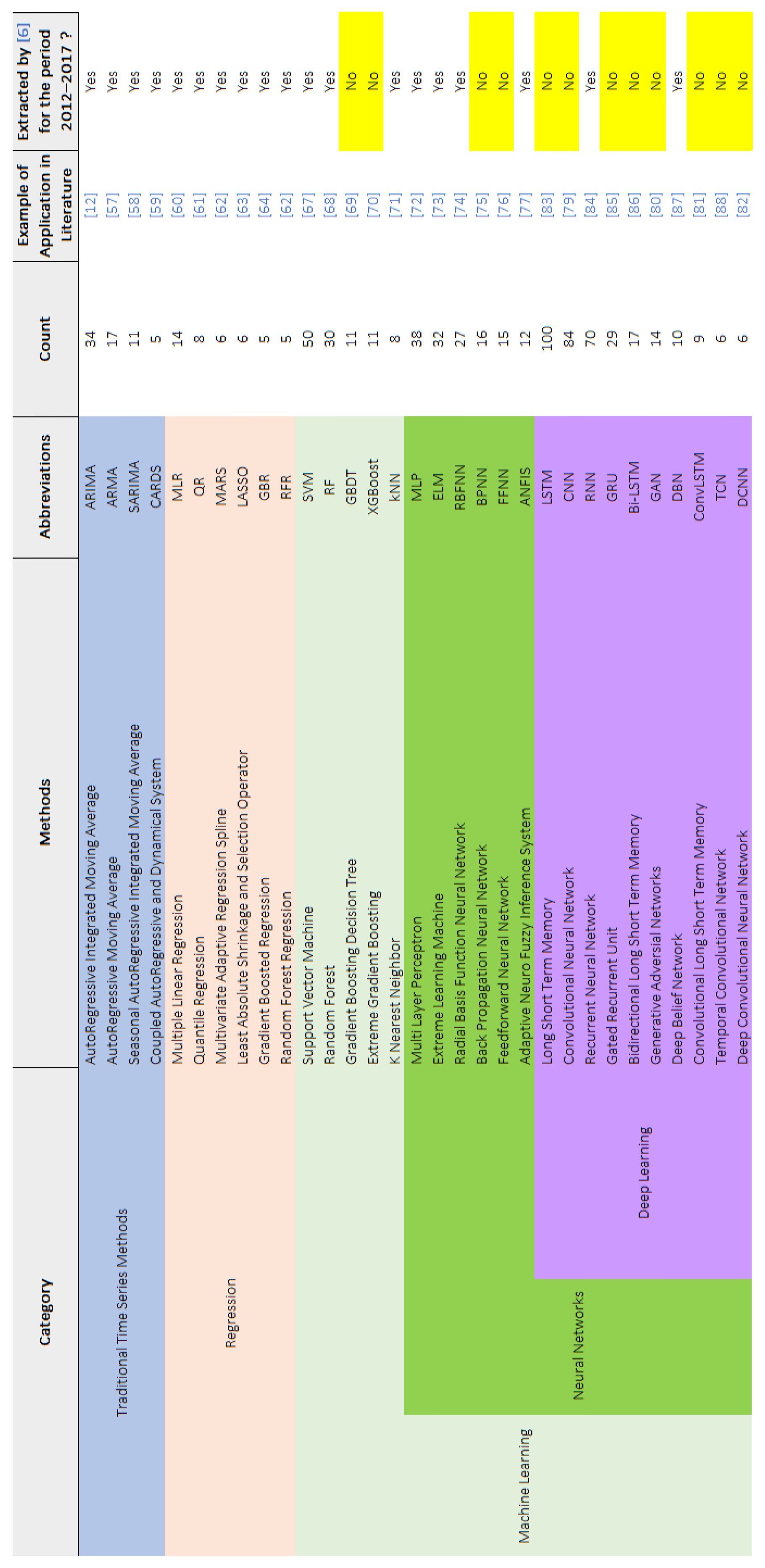
- Persistence:
4.3.3. Hybridization
- Ref. [12] combines cloudiness information as an exogenous variable with ground measurements to enhance forecast performance.
- Ref. [97] integrates satellite and sky images for improved deterministic and probabilistic intra-hour GHI forecasting.
- Ref. [98] merges same-day NWP forecasts with satellite data for more accurate forecasting.
4.4. Error Metrics
- Metrics assessing Prediction Interval (PI) quality: Prediction Interval Normalized Average Width (PINAW), Prediction Interval Coverage Probability (PICP), and Coverage Width-based Criterion (CWC).
- Metrics evaluating Cumulative Distribution Function (CDF) quality: Brier Score (BS) and Continuous Ranked Probability Score (CRPS).
5. Distinction Between Forecasting, Prediction, and Estimation
6. Companies
7. Discussion
8. Conclusions
Author Contributions
Funding
Data Availability Statement
Conflicts of Interest
Abbreviations
| ANFIS | Adaptive Neuro-Fuzzy Inference System |
| API | Application Programming Interface |
| ARIMA | AutoRegressive Integrated Moving Average |
| ARMA | AutoRegressive Moving Average |
| AROME | Application of Research to Operations at Mesoscale |
| ASI | All Sky Imager |
| Bi-LSTM | Bidirectional Long Short-Term Memory |
| BHI | Beam Horizontal Irradiance |
| BHI | Beam Horizontal Irradiation |
| BNI | Beam Normal Irradiance |
| BNI | Beam Normal Irradiation |
| BPNN | Back Propagation Neural Network |
| BSRN | Baseline Surface Radiation Network |
| CARDS | Coupled AutoRegressive and Dynamical System |
| CDF | Cumulative Distribution Function |
| CNN | Convolutional Neural Network |
| ConvLSTM | Convolutional Long Short-Term Memory |
| CRPS | Continuous Ranked Probability Score |
| CWC | Coverage Width-based Criterion |
| DCNN | Deep Convolutional Neural Network |
| DBN | Deep Belief Network |
| DHI | Diffuse Horizontal Irradiance |
| DHI | Diffuse Horizontal Irradiation |
| DNI | Direct Normal Irradiance |
| DNI | Direct Normal Irradiation |
| ECMWF | European Centre for Medium-Range Weather Forecasts |
| ELM | Extreme Learning Machine |
| EPS | Ensemble Prediction Systems |
| EUMETSAT | European Organization for the Exploitation of Meteorological Satellites |
| FFNN | Feedforward Neural Network |
| GANs | Generative Adversarial Networks |
| GBR | Gradient Boosted Regression |
| GBDT | Gradient Boosting Decision Tree |
| GFS | Global Forecast System |
| GHI | Global Horizontal Irradiance |
| GHI | Global Horizontal Irradiation |
| GRU | Gated Recurrent Unit |
| GTI | Global Tilted Irradiance |
| GTI | Global Tilted Irradiation |
| HTML | HyperText Markup Language |
| HRES | High-Resolution Forecast System |
| IEEE | Institute of Electrical and Electronics Engineers |
| JMA | Japan Meteorological Agency |
| kNN | k Nearest Neighbors |
| LASSO | Least Absolute Shrinkage and Selection Operator |
| LSTM | Long Short-Term Memory |
| MAD | Mean Average Deviation |
| MAE | Mean Absolute Error |
| MAPE | Mean Absolute Percentage Error |
| MARS | Multivariate Adaptive Regression Spline |
| MBE | Mean Bias Error |
| MLR | Multiple Linear Regression |
| MLP | Multi-Layer Perceptron |
| MPE | Mean Percentage Error |
| MRE | Mean Relative Error |
| MSE | Mean Squared Error |
| NAM | North American Mesoscale |
| NCAR | National Center for Atmospheric Research |
| NCEI | National Centers for Environmental Information |
| NOAA | National Oceanic and Atmospheric Administration |
| nRMSE | Normalized Root Mean Square Error |
| NWP | Numerical Weather Prediction |
| nMAE | Normalized Mean Absolute Error |
| nMBE | Normalized Mean Bias Error |
| Probability Distribution Function | |
| PI | Prediction Interval |
| PICP | Prediction Interval Coverage Probability |
| PINAW | Prediction Interval Normalized Average Width |
| POA | Plane of Array |
| QR | Quantile Regression |
| RBFNN | Radial Basis Function Neural Network |
| RF | Random Forest |
| RFR | Random Forest Regression |
| RMSE | Root Mean Square Error |
| RNN | Recurrent Neural Network |
| rRMSE | Relative Root Mean Square Error |
| RTM | Radiative Transfer Models |
| SARIMA | Seasonal AutoRegressive Integrated Moving Average |
| SP | Smart Persistence |
| SVM | Support Vector Machine |
| TCN | Temporal Convolutional Network |
| TMY | Typical Meteorological Year |
| TSI | Total Sky Imager |
| WRF | Weather Research and Forecasting |
| WSI | Whole Sky Imager |
| XGBoost | Extreme Gradient Boosting |
References
- IEA PVPS. Trends in Photovoltaic Applications 2023. International Energy Agency Photovoltaic Power Systems Programme, 2023. Available online: https://iea-pvps.org/wp-content/uploads/2023/10/PVPS_Trends_Report_2023_WEB.pdf (accessed on 3 September 2025).
- Diagne, M.; David, M.; Lauret, P.; Boland, J.; Schmutz, N. Review of solar irradiance forecasting methods and a proposition for small-scale insular grids. Renew. Sustain. Energy Rev. 2013, 27, 65–76. [Google Scholar] [CrossRef]
- Chaturvedi, K.D.; Isha, I. Solar power forecasting: A review. Int. J. Comput. Appl. 2016, 45, 28–50. [Google Scholar] [CrossRef]
- Galati, F.; Bigliardi, B. Industry 4.0: Emerging themes and future research avenues using a text mining approach. Comput. Ind. 2019, 109, 100–113. [Google Scholar] [CrossRef]
- Pande, V.C.; Khandelwal, A.S. A survey of different text mining techniques. IBMRD J. Manag. Res. 2014, 3, 125–133. Available online: http://www.ibmrdjournal.com (accessed on 3 September 2025).
- Yang, D.; Kleissl, J.; Gueymard, C.A.; Pedro, H.T.C.; Coimbra, C.F.M. History and trends in solar irradiance and PV power forecasting: A preliminary assessment and review using text mining. Sol. Energy 2018, 168, 60–101. [Google Scholar] [CrossRef]
- Paletta, Q.; Terrén-Serrano, G.; Nie, Y.; Li, B.; Bieker, J.; Zhang, W.; Dubus, L.; Dev, S.; Feng, C. Advances in solar forecasting: Computer vision with deep learning. Adv. Appl. Energy 2023, 11, 100150. [Google Scholar] [CrossRef]
- Gusenbauer, M.; Haddaway, N.R. Which academic search systems are suitable for systematic reviews or meta-analyses? Res. Synth. Methods 2020, 11, 181–217. [Google Scholar] [CrossRef]
- Hwang, C.M.; Yang, M.S.; Hung, W.L. New similarity measures of intuitionistic fuzzy sets based on the Jaccard index with its application to clustering. Int. J. Intell. Syst. 2018, 33, 1672–1688. [Google Scholar] [CrossRef]
- Schwartz, A.S.; Hearst, M.A. A simple algorithm for identifying abbreviation definitions in biomedical text. In Biocomputing; World Scientific: Singapore, 2003; pp. 451–462. [Google Scholar] [CrossRef]
- Azizi, N.; Yaghoubirad, M.; Farajollahi, M.; Ahmadi, A. Deep learning based long-term global solar irradiance and temperature forecasting using time series with multi-step multivariate output. Renew. Energy 2023, 206, 135–147. [Google Scholar] [CrossRef]
- Chodakowska, E.; Nazarko, J.; Nazarko, Ł.; Rabayah, H.S.; Abendeh, R.M.; Alawneh, R. ARIMA models in solar radiation forecasting in different geographic locations. Energies 2023, 16, 5029. [Google Scholar] [CrossRef]
- Neshat, M.; Nezhad, M.M.; Mirjalili, S.; Garcia, D.A.; Dahlquist, E.; Gandomi, A.H. Short-term solar radiation forecasting using hybrid deep residual learning and gated LSTM recurrent network with differential covariance matrix adaptation evolution strategy. Energy 2023, 278, 127701. [Google Scholar] [CrossRef]
- Yildirim, A.; Bilgili, M.; Ozbek, A. One-hour-ahead solar radiation forecasting by MLP, LSTM, and ANFIS approaches. Meteorol. Atmos. Phys. 2023, 135, 10. [Google Scholar] [CrossRef]
- Al-Ali, E.M.; Hajji, Y.; Said, Y.; Hleili, M.; Alanzi, A.M.; Laatar, A.H.; Atri, M. Solar energy production forecasting based on a hybrid CNN-LSTM-Transformer model. Mathematics 2023, 11, 676. [Google Scholar] [CrossRef]
- Kim, E.; Akhtar, M.S.; Yang, O.B. Designing solar power generation output forecasting methods using time series algorithms. Electr. Power Syst. Res. 2023, 216, 109073. [Google Scholar] [CrossRef]
- AlKandari, M.; Ahmad, I. Solar power generation forecasting using ensemble approach based on deep learning and statistical methods. Appl. Comput. Inform. 2024, 20, 231–250. [Google Scholar] [CrossRef]
- Alharkan, H.; Habib, S.; Islam, M. Solar power prediction using dual stream CNN-LSTM architecture. Sensors 2023, 23, 945. [Google Scholar] [CrossRef]
- Huang, C.; Yang, M. Memory long and short-term time series network for ultra-short-term photovoltaic power forecasting. Energy 2023, 279, 127961. [Google Scholar] [CrossRef]
- Yang, D.; Dong, Z.; Nobre, A.; Khoo, Y.S.; Jirutitijaroen, P.; Walsh, W.M. Evaluation of transposition and decomposition models for converting global solar irradiance from tilted surface to horizontal in tropical regions. Sol. Energy 2013, 97, 369–387. [Google Scholar] [CrossRef]
- Yang, D. Solar radiation on inclined surfaces: Corrections and benchmarks. Sol. Energy 2016, 136, 288–302. [Google Scholar] [CrossRef]
- Mubarak, R.; Hofmann, M.; Riechelmann, S.; Seckmeyer, G. Comparison of modelled and measured tilted solar irradiance for photovoltaic applications. Energies 2017, 10, 1688. [Google Scholar] [CrossRef]
- Evseev, E.G.; Kudish, A.I. The assessment of different models to predict the global solar radiation on a surface tilted to the south. Sol. Energy 2009, 83, 377–388. [Google Scholar] [CrossRef]
- Notton, G.; Voyant, C.; Fouilloy, A.; Duchaud, J.L.; Nivet, M.L. Some applications of ANN to solar radiation estimation and forecasting for energy applications. Appl. Sci. 2019, 9, 209. [Google Scholar] [CrossRef]
- Evans, D.L. Simplified method for predicting photovoltaic array output. Sol. Energy 1981, 27, 555–560. [Google Scholar] [CrossRef]
- Blanc, P.; Remund, J.; Vallance, L. Short-term solar power forecasting based on satellite images. In Renewable Energy Forecasting; Kariniotakis, G., Ed.; Woodhead Publishing: Cambridge, UK, 2017; pp. 179–198. [Google Scholar] [CrossRef]
- Antonanzas, J.; Osorio, N.; Escobar, R.; Urraca, R.; Martinez-de-Pison, F.J.; Antonanzas-Torres, F. Review of photovoltaic power forecasting. Sol. Energy 2016, 136, 78–111. [Google Scholar] [CrossRef]
- Zhang, Y.; Wang, J.; Wang, X. Review on probabilistic forecasting of wind power generation. Renew. Sustain. Energy Rev. 2014, 32, 255–270. [Google Scholar] [CrossRef]
- Alessandrini, S.; Delle Monache, L.; Sperati, S.; Cervone, G. An analog ensemble for short-term probabilistic solar power forecast. Appl. Energy 2015, 157, 95–110. [Google Scholar] [CrossRef]
- David, M.; Ramahatana, F.; Trombe, P.J.; Lauret, P. Probabilistic forecasting of the solar irradiance with recursive ARMA and GARCH models. Sol. Energy 2016, 133, 55–72. [Google Scholar] [CrossRef]
- He, Y.; Yan, Y.; Xu, Q. Wind and solar power probability density prediction via fuzzy information granulation and support vector quantile regression. Int. J. Electr. Power Energy Syst. 2019, 113, 515–527. [Google Scholar] [CrossRef]
- Huang, J.; Thatcher, M. Assessing the value of simulated regional weather variability in solar forecasting using numerical weather prediction. Sol. Energy 2017, 144, 529–539. [Google Scholar] [CrossRef]
- Doubleday, K.; Van Scyoc Hernandez, V.; Hodge, B.M. Benchmark probabilistic solar forecasts: Characteristics and recommendations. Sol. Energy 2020, 206, 52–67. [Google Scholar] [CrossRef]
- Voyant, C.; Motte, F.; Notton, G.; Fouilloy, A.; Nivet, M.L.; Duchaud, J.L. Prediction intervals for global solar irradiation forecasting using regression trees methods. Renew. Energy 2018, 126, 332–340. [Google Scholar] [CrossRef]
- Li, K.; Wang, R.; Lei, H.; Zhang, T.; Liu, Y.; Zheng, X. Interval prediction of solar power using an Improved Bootstrap method. Sol. Energy 2018, 159, 97–112. [Google Scholar] [CrossRef]
- David, M.; Le Gal La Salle, J.; Ramahatana Andriamasomanana, F.H.; Lauret, P. Probabilistic solar forecasts evaluation Part 1: Ensemble prediction systems (EPS). In Proceedings of the ISES Solar World Congress 2019/IEA SHC International Conference, Santiago, Chile, 3–7 November 2019; pp. 1–9. [Google Scholar] [CrossRef]
- Duchaud, J.L.; Voyant, C.; Fouilloy, A.; Notton, G.; Nivet, M.L. Trade-off between precision and resolution of a solar power forecasting algorithm for micro-grid optimal control. Energies 2020, 13, 3565. [Google Scholar] [CrossRef]
- Mitra, I.; Heinemann, D.; Ramanan, A.; Kaur, M.; Sharma, S.K.; Tripathy, S.K.; Roy, A. Short-term PV power forecasting in India: Recent developments and policy analysis. Int. J. Energy Environ. Eng. 2022, 13, 515–540. [Google Scholar] [CrossRef]
- Betti, A.; Pierro, M.; Cornaro, C.; Moser, D.; Moschella, M.; Collino, E.; Ronzio, D.; van der Meer, D.; Widén, J.; Visser, L.; et al. Regional Solar Power Forecasting; IEA-PVPS: Paris, France, 2020; Available online: https://iea-pvps.org/research-tasks/regional-solar-power-forecasting/ (accessed on 28 September 2025).
- Yang, B.; Zhu, T.; Cao, P.; Guo, Z.; Zeng, C.; Li, D.; Chen, Y.; Ye, H.; Shao, R.; Shu, H. Classification and summarization of solar irradiance and power forecasting methods: A thorough review. CSEE J. Power Energy Syst. 2023, 9, 978–995. [Google Scholar] [CrossRef]
- Carrière, T.; Amaro, E.; Silva, R.; Zhuang, F.; Saint-Drenan, Y.M.; Blanc, P. A new approach for satellite-based probabilistic solar forecasting with cloud motion vectors. Energies 2021, 14, 4951. [Google Scholar] [CrossRef]
- Magnone, L.; Sossan, F.; Scolari, E.; Paolone, M. Cloud motion identification algorithms based on all-sky images to support solar irradiance forecast. In Proceedings of the 2017 IEEE 44th Photovoltaic Specialist Conference (PVSC), Washington, DC, USA, 25–30 June 2017; pp. 1415–1420. [Google Scholar] [CrossRef]
- Ning, Z.; Hochard, G. Eyes in the Heavens: Satellite technologies in remote site monitoring. Geostrata 2017, 21, 50–55. [Google Scholar] [CrossRef]
- Lin, F.; Zhang, Y.; Wang, J. Recent advances in intra-hour solar forecasting: A review of ground-based sky image methods. Int. J. Forecast. 2023, 39, 244–265. [Google Scholar] [CrossRef]
- Logothetis, S.-A.; Salamalikis, V.; Nouri, B.; Remund, J.; Zarzalejo, L.F.; Xie, Y.; Wilbert, S.; Ntavelis, E.; Nou, J.; Hendrikx, N.; et al. Solar irradiance ramp forecasting based on all-sky imagers. Energies 2022, 15, 6191. [Google Scholar] [CrossRef]
- Leutbecher, M.; Palmer, T.N. Ensemble forecasting. J. Comput. Phys. 2008, 227, 3515–3539. [Google Scholar] [CrossRef]
- Barhmi, K.; Heynen, C.; Golroodbari, S.; Van Sark, W. A review of solar forecasting techniques and the role of artificial intelligence. Solar 2024, 4, 99–135. [Google Scholar] [CrossRef]
- Nielsen, A.H.; Iosifidis, A.; Karstoft, H. IrradianceNet: Spatiotemporal deep learning model for satellite-derived solar irradiance short-term forecasting. Sol. Energy 2021, 228, 659–669. [Google Scholar] [CrossRef]
- Le Gal La Salle, J.; David, M.; Lauret, P. A new climatology reference model to benchmark probabilistic solar forecasts. Sol. Energy 2021, 223, 398–414. [Google Scholar] [CrossRef]
- Boilley, A.; Thomas, C.; Marchand, M.; Wey, E.; Blanc, P. The solar forecast similarity method: A new method to compute solar radiation forecasts for the next day. Energy Procedia 2016, 91, 1018–1023. [Google Scholar] [CrossRef]
- Inman, R.H.; Pedro, H.T.C.; Coimbra, C.F.M. Solar forecasting methods for renewable energy integration. Prog. Energy Combust. Sci. 2013, 39, 535–576. [Google Scholar] [CrossRef]
- Yang, D. Choice of clear-sky model in solar forecasting. J. Renew. Sustain. Energy 2020, 12, 026101. [Google Scholar] [CrossRef]
- Garniwa, P.M.P.; Rajagukguk, R.A.; Kamil, R.; Lee, H. Intraday forecast of global horizontal irradiance using optical flow method and long short-term memory model. Sol. Energy 2023, 252, 234–251. [Google Scholar] [CrossRef]
- Rigollier, C.; Lefèvre, M.; Wald, L. The method Heliosat-2 for deriving shortwave solar radiation from satellite images. Sol. Energy 2004, 77, 159–169. [Google Scholar] [CrossRef]
- Caldas, M.; Alonso-Suárez, R. Very short-term solar irradiance forecast using all-sky imaging and real-time irradiance measurements. Renew. Energy 2019, 143, 1643–1658. [Google Scholar] [CrossRef]
- Pedro, H.T.C.; Coimbra, C.F.M.; David, M.; Lauret, P. Assessment of machine learning techniques for deterministic and probabilistic intra-hour solar forecasts. Renew. Energy 2018, 123, 191–203. [Google Scholar] [CrossRef]
- Colak, I.; Yesilbudak, M.; Genc, N.; Bayindir, R. Multi-period prediction of solar radiation using ARMA and ARIMA models. In Proceedings of the 2015 IEEE 14th International Conference on Machine Learning and Applications (ICMLA), Miami, FL, USA, 9–11 December 2015; pp. 1045–1049. [Google Scholar] [CrossRef]
- Kushwaha, V.; Pindoriya, N.M. Very short-term solar PV generation forecast using SARIMA model: A case study. In Proceedings of the 2017 7th International Conference on Power Systems (ICPS), Pune, India, 21–23 December 2017; pp. 430–435. [Google Scholar] [CrossRef]
- Huang, J.; Korolkiewicz, M.; Agrawal, M.; Boland, J. Forecasting solar radiation on an hourly time scale using a Coupled AutoRegressive and Dynamical System (CARDS) model. Sol. Energy 2013, 87, 136–149. [Google Scholar] [CrossRef]
- Abuella, M.; Chowdhury, B. Solar power probabilistic forecasting by using multiple linear regression analysis. In Proceedings of the SoutheastCon 2015, Fort Lauderdale, FL, USA, 9–12 April 2015; pp. 1–5. [Google Scholar] [CrossRef]
- Lauret, P.; David, M.; Pedro, H. Probabilistic solar forecasting using quantile regression models. Energies 2017, 10, 1591. [Google Scholar] [CrossRef]
- Srivastava, R.; Tiwari, A.N.; Giri, V.K. Solar radiation forecasting using MARS, CART, M5, and random forest model: A case study for India. Heliyon 2019, 5, e02692. [Google Scholar] [CrossRef] [PubMed]
- Tang, N.; Mao, S.; Wang, Y.; Nelms, R.M. Solar power generation forecasting with a LASSO-based approach. IEEE Internet Things J. 2018, 5, 1090–1099. [Google Scholar] [CrossRef]
- Persson, C.; Bacher, P.; Shiga, T.; Madsen, H. Multi-site solar power forecasting using gradient boosted regression trees. Sol. Energy 2017, 150, 423–436. [Google Scholar] [CrossRef]
- Bakker, K.; Whan, K.; Knap, W.; Schmeits, M. Comparison of statistical post-processing methods for probabilistic NWP forecasts of solar radiation. Sol. Energy 2019, 191, 138–150. [Google Scholar] [CrossRef]
- Verbois, H.; Saint-Drenan, Y.M.; Thiery, A.; Blanc, P. Statistical learning for NWP post-processing: A benchmark for solar irradiance forecasting. Sol. Energy 2022, 238, 132–149. [Google Scholar] [CrossRef]
- Zeng, J.; Qiao, W. Short-term solar power prediction using a support vector machine. Renew. Energy 2013, 52, 118–127. [Google Scholar] [CrossRef]
- Benali, L.; Notton, G.; Fouilloy, A.; Voyant, C.; Dizene, R. Solar radiation forecasting using artificial neural network and random forest methods: Application to normal beam, horizontal diffuse and global components. Renew. Energy 2019, 132, 871–884. [Google Scholar] [CrossRef]
- Wang, J.; Li, P.; Ran, R.; Che, Y.; Zhou, Y. A short-term photovoltaic power prediction model based on the gradient boost decision tree. Appl. Sci. 2018, 8, 689. [Google Scholar] [CrossRef]
- Li, X.; Ma, L.; Chen, P.; Xu, H.; Xing, Q.; Yan, J.; Lu, S.; Fan, H.; Yang, L.; Cheng, Y. Probabilistic solar irradiance forecasting based on XGBoost. Energy Rep. 2022, 8, 1087–1095. [Google Scholar] [CrossRef]
- Chu, Y.; Coimbra, C.F.M. Short-term probabilistic forecasts for direct normal irradiance. Renew. Energy 2017, 101, 526–536. [Google Scholar] [CrossRef]
- Muhammad Ehsan, R.; Simon, S.P.; Venkateswaran, P.R. Day-ahead forecasting of solar photovoltaic output power using multilayer perceptron. Neural Comput. Appl. 2017, 28, 3981–3992. [Google Scholar] [CrossRef]
- Rehiara, A.B.; Setiawidayat, S. Day ahead solar irradiation forecasting based on extreme learning machine. In Proceedings of the 2022 IEEE International Conference on Cybernetics and Computational Intelligence (CyberneticsCom), Malang, Indonesia, 16–18 June 2022; pp. 63–66. [Google Scholar] [CrossRef]
- Hong, Y.Y.; Chan, Y.H.; Yu, C.W. One-hour ahead solar irradiance/power forecasting using radial basis function neural network with fuzzy activation function. In Proceedings of the 2020 International Symposium on Computer, Consumer and Control (IS3C), Taichung City, Taiwan, 13–16 November 2020; pp. 339–343. [Google Scholar] [CrossRef]
- Aghmadi, A.; El Hani, S.; Mediouni, H.; Naseri, N.; El Issaoui, F. Hybrid solar forecasting method based on empirical mode decomposition and back propagation neural network. E3S Web Conf. 2021, 231, 02001. [Google Scholar] [CrossRef]
- Husein, M.; Chung, I.Y. Day-ahead solar irradiance forecasting for microgrids using a long short-term memory recurrent neural network: A deep learning approach. Energies 2019, 12, 1856. [Google Scholar] [CrossRef]
- Perveen, G.; Rizwan, M.; Goel, N. An ANFIS-based model for solar energy forecasting and its smart grid application. Eng. Rep. 2019, 1, e12070. [Google Scholar] [CrossRef]
- Martin, R.; Aler, R.; Valls, J.M.; Galvan, I.M. Machine learning techniques for daily solar energy prediction and interpolation using numerical weather models. Concurr. Comput. Pract. Exp. 2016, 28, 1261–1274. [Google Scholar] [CrossRef]
- Feng, C.; Zhang, J.; Zhang, W.; Hodge, B.M. Convolutional neural networks for intra-hour solar forecasting based on sky image sequences. Appl. Energy 2022, 310, 118438. [Google Scholar] [CrossRef]
- Wen, H.; Du, Y.; Chen, X.; Lim, E.G.; Wen, H.; Yan, K. A regional solar forecasting approach using generative adversarial networks with solar irradiance maps. Renew. Energy 2023, 216, 119043. [Google Scholar] [CrossRef]
- Agga, A.; Abbou, A.; Labbadi, M.; El Houm, Y. Short-term self-consumption PV plant power production forecasts based on hybrid CNN-LSTM, ConvLSTM models. Renew. Energy 2021, 177, 101–112. [Google Scholar] [CrossRef]
- Wang, H.; Yi, H.; Peng, J.; Wang, G.; Liu, Y.; Jiang, H.; Liu, W. Deterministic and probabilistic forecasting of photovoltaic power based on deep convolutional neural network. Energy Convers. Manag. 2017, 153, 409–422. [Google Scholar] [CrossRef]
- Yu, Y.; Cao, J.; Zhu, J. An LSTM short-term solar irradiance forecasting under complicated weather conditions. IEEE Access 2019, 7, 145651–145666. [Google Scholar] [CrossRef]
- Jaihuni, M.; Basak, J.K.; Khan, F.; Okyere, F.G.; Sihalath, T.; Bhujel, A.; Park, J.; Lee, D.H.; Kim, H.T. A novel recurrent neural network approach in forecasting short term solar irradiance. ISA Trans. 2022, 121, 63–74. [Google Scholar] [CrossRef] [PubMed]
- Wojtkiewicz, J.; Hosseini, M.; Gottumukkala, R.; Chambers, T.L. Hour-ahead solar irradiance forecasting using multivariate gated recurrent units. Energies 2019, 12, 4055. [Google Scholar] [CrossRef]
- Zameer, A.; Jaffar, F.; Shahid, F.; Muneeb, M.; Khan, R.; Nasir, R. Short-term solar energy forecasting: Integrated computational intelligence of LSTMs and GRU. PLoS ONE 2023, 18, e0285410. [Google Scholar] [CrossRef]
- Neo, Y.Q.; Teo, T.T.; Woo, W.L.; Logenthiran, T.; Sharma, A. Forecasting of photovoltaic power using deep belief network. In Proceedings of the TENCON 2017—IEEE Region 10 Conference, Penang, Malaysia, 5–8 November 2017; pp. 1189–1194. [Google Scholar] [CrossRef]
- Lin, Y.; Koprinska, I.; Rana, M. Temporal convolutional neural networks for solar power forecasting. In Proceedings of the 2020 International Joint Conference on Neural Networks (IJCNN), Glasgow, UK, 19–24 July 2020; pp. 1–8. [Google Scholar] [CrossRef]
- Papazek, P.; Schicker, I. A deep learning LSTM forecasting approach for renewable energy systems. In Proceedings of the EGU General Assembly 2021, Online, 19–30 April 2021; p. EGU21-9910. [Google Scholar] [CrossRef]
- Gneiting, T.; Lerch, S.; Schulz, B. Probabilistic solar forecasting: Benchmarks, post-processing, verification. Sol. Energy 2023, 252, 72–80. [Google Scholar] [CrossRef]
- Benavides Cesar, L.; Amaro, E.; Silva, R.; Manso Callejo, M.Á.; Cira, C.I. Review on spatio-temporal solar forecasting methods driven by in situ measurements or their combination with satellite and numerical weather prediction (NWP) estimates. Energies 2022, 15, 4341. [Google Scholar] [CrossRef]
- Chen, X.; Du, Y.; Lim, E.; Fang, L.; Yan, K. Towards the applicability of solar nowcasting: A practice on predictive PV power ramp-rate control. Renew. Energy 2022, 195, 147–166. [Google Scholar] [CrossRef]
- Yang, D. Making reference solar forecasts with climatology, persistence, and their optimal convex combination. Sol. Energy 2019, 193, 981–985. [Google Scholar] [CrossRef]
- Liu, B.; Wang, J.; Chen, J.; Li, B.; Sun, D.; Zhang, G. A probabilistic perspective on predictability of solar irradiance using bootstrapped correlograms and ensemble predictability error growth. Sol. Energy 2023, 260, 17–24. [Google Scholar] [CrossRef]
- Voyant, C.; Notton, G.; Duchaud, J.-L.; Gutiérrez, L.; Bright, J.M.; Yang, D. Benchmarks for solar radiation time series forecasting. Renew. Energy 2022, 191, 747–762. [Google Scholar] [CrossRef]
- Hong, T.; Pinson, P.; Wang, Y.; Weron, R.; Yang, D.; Zareipour, H. Energy forecasting: A review and outlook. IEEE Open J. Power Energy 2020, 7, 376–388. [Google Scholar] [CrossRef]
- Paletta, Q.; Arbod, G.; Lasenby, J. Omnivision forecasting: Combining satellite and sky images for improved deterministic and probabilistic intra-hour solar energy predictions. Appl. Energy 2023, 336, 120818. [Google Scholar] [CrossRef]
- Catalina, A.; Alaiz, C.M.; Dorronsoro, J.R. Combining numerical weather predictions and satellite data for PV energy nowcasting. IEEE Trans. Sustain. Energy 2020, 11, 1930–1937. [Google Scholar] [CrossRef]
- Sansine, V.; Ortega, P.; Hissel, D.; Ferrucci, F. Hybrid deep learning model for mean hourly irradiance probabilistic forecasting. Atmosphere 2023, 14, 1192. [Google Scholar] [CrossRef]
- Shan, S.; Li, C.; Ding, Z.; Wang, Y.; Zhang, K.; Wei, H. Ensemble learning based multi-modal intra-hour irradiance forecasting. Energy Convers. Manag. 2022, 270, 116206. [Google Scholar] [CrossRef]
- Carrillo, R.E.; Leblanc, M.; Schubnel, B.; Langou, R.; Topfel, C.; Alet, P.J. High-resolution PV forecasting from imperfect data: A graph-based solution. Energies 2020, 13, 5763. [Google Scholar] [CrossRef]
- Singla, P.; Duhan, M.; Saroha, S. Review of different error metrics: A case of solar forecasting. AIUB J. Sci. Eng. 2021, 20, 158–165. [Google Scholar] [CrossRef]
- Sobri, S.; Koohi-Kamali, S.; Rahim, N.A. Solar photovoltaic generation forecasting methods: A review. Energy Convers. Manag. 2018, 156, 459–497. [Google Scholar] [CrossRef]
- Voyant, C.; Notton, G.; Kalogirou, S.; Nivet, M.-L.; Paoli, C.; Motte, F.; Fouilloy, A. Machine learning methods for solar radiation forecasting: A review. Renew. Energy 2017, 105, 569–582. [Google Scholar] [CrossRef]
- Yagli, G.M.; Yang, D.; Srinivasan, D. Ensemble solar forecasting using data-driven models with probabilistic post-processing through GAMLSS. Sol. Energy 2020, 208, 612–622. [Google Scholar] [CrossRef]
- Alonso-Suárez, R.; David, M.; Branco, V.; Lauret, P. Intra-day solar probabilistic forecasts including local short-term variability and satellite information. Renew. Energy 2020, 158, 554–573. [Google Scholar] [CrossRef]
- Massidda, L.; Marrocu, M. Quantile regression post-processing of weather forecast for short-term solar power probabilistic forecasting. Energies 2018, 11, 1763. [Google Scholar] [CrossRef]
- Heydari, A.; Astiaso Garcia, D.; Keynia, F.; Bisegna, F.; De Santoli, L. A novel composite neural network based method for wind and solar power forecasting in microgrids. Appl. Energy 2019, 251, 113353. [Google Scholar] [CrossRef]
- Demir, V.; Citakoglu, H. Forecasting of solar radiation using different machine learning approaches. Neural Comput. Appl. 2023, 35, 887–906. [Google Scholar] [CrossRef]
- Obiora, C.N.; Ali, A.; Hasan, A.N. Forecasting hourly solar irradiance using long short-term memory (LSTM) network. In Proceedings of the 2020 11th International Renewable Energy Congress (IREC), Hammamet, Tunisia, 29–31 October 2020; pp. 1–6. [Google Scholar] [CrossRef]
- Alam, M.S.; Al-Ismail, F.S.; Hossain, M.S.; Rahman, S.M. Ensemble machine-learning models for accurate prediction of solar irradiation in Bangladesh. Processes 2023, 11, 908. [Google Scholar] [CrossRef]
- Arora, I.; Gambhir, J.; Kaur, T. Solar irradiance forecasting using decision tree and ensemble models. In Proceedings of the 2020 2nd International Conference on Inventive Research in Computing Applications (ICIRCA), Coimbatore, India, 15–17 July 2020; pp. 675–681. [Google Scholar] [CrossRef]
- Mathiesen, P.; Kleissl, J. Evaluation of numerical weather prediction for intra-day solar forecasting in the continental United States. Sol. Energy 2011, 85, 967–977. [Google Scholar] [CrossRef]
- Nespoli, A.; Ogliari, E.; Leva, S.; Pavan, A.M.; Mellit, A.; Lughi, V.; Dolara, A. Day-ahead photovoltaic forecasting: A comparison of the most effective techniques. Energies 2019, 12, 1621. [Google Scholar] [CrossRef]
- Mohammadi, K.; Shamshirband, S.; Anisi, M.H.; Alam, K.A.; Petković, D. Support vector regression based prediction of global solar radiation on a horizontal surface. Energy Convers. Manag. 2015, 91, 433–441. [Google Scholar] [CrossRef]
- Blaga, R.; Sabadus, A.; Stefu, N.; Dughir, C.; Paulescu, M.; Badescu, V. A current perspective on the accuracy of incoming solar energy forecasting. Prog. Energy Combust. Sci. 2019, 70, 119–144. [Google Scholar] [CrossRef]
- Zulkifly, Z.; Baharin, K.A.; Gan, C.K. Improved machine learning model selection technique for solar energy forecasting applications. Int. J. Renew. Energy Res. 2021, 11, 308–319. [Google Scholar] [CrossRef]
- Lateko, A.A.H.; Yang, H.T.; Huang, C.M. Short-term PV power forecasting using a regression-based ensemble method. Energies 2022, 15, 4171. [Google Scholar] [CrossRef]
- Babatunde, O.M.; Munda, J.L.; Hamam, Y.; Monyei, C.G. A critical overview of the (Im)practicability of solar radiation forecasting models. e-Prime Adv. Electr. Eng. Electron. Energy 2023, 5, 100213. [Google Scholar] [CrossRef]
- Kashyap, Y.; Bansal, A.; Sao, A.K. Solar radiation forecasting with multiple parameters neural networks. Renew. Sustain. Energy Rev. 2015, 49, 825–835. [Google Scholar] [CrossRef]
- Khatib, T.; Mohamed, A.; Sopian, K.; Mahmoud, M. Assessment of Artificial Neural Networks for Hourly Solar Radiation Prediction. Int. J. Photoenergy 2012, 2012, 946890. [Google Scholar] [CrossRef]
- Lorenz, E.; Nouri, B.; Cros, S.; Nielsen, K.P.; Fritz, R.; Good, G.; Pierro, M.; Hernandez, G.S.; Lauret, P.; David, M. Forecasting Solar Radiation and Photovoltaic Power. In Best Practices Handbook for the Collection and Use of Solar Resource Data for Solar Energy Applications, 4th ed.; Springer: Cham, Switzerland, 2024. [Google Scholar] [CrossRef]
- Kopecek, R.; Libal, J. Bifacial photovoltaics 2021: Status, opportunities and challenges. Energies 2021, 14, 2076. [Google Scholar] [CrossRef]
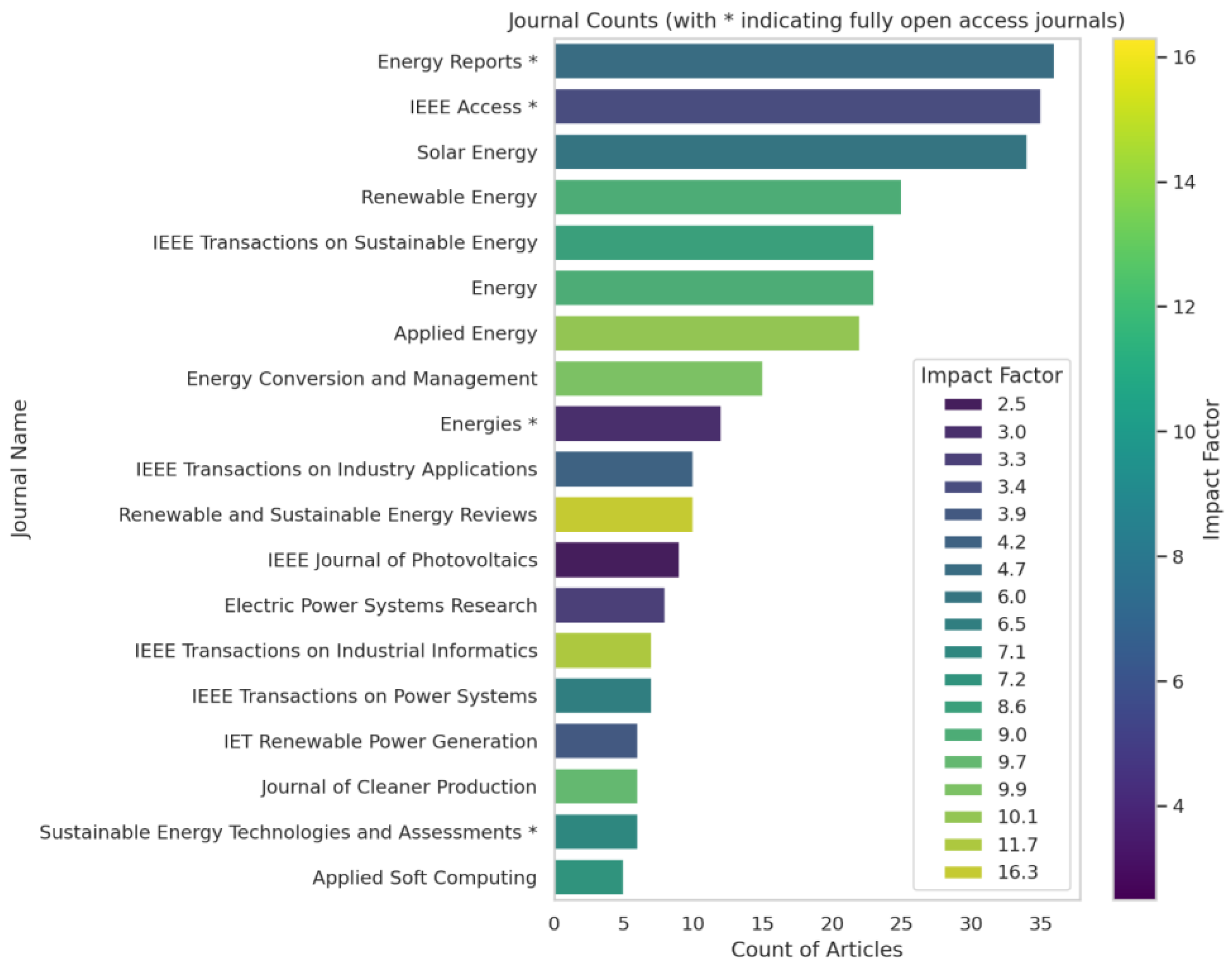
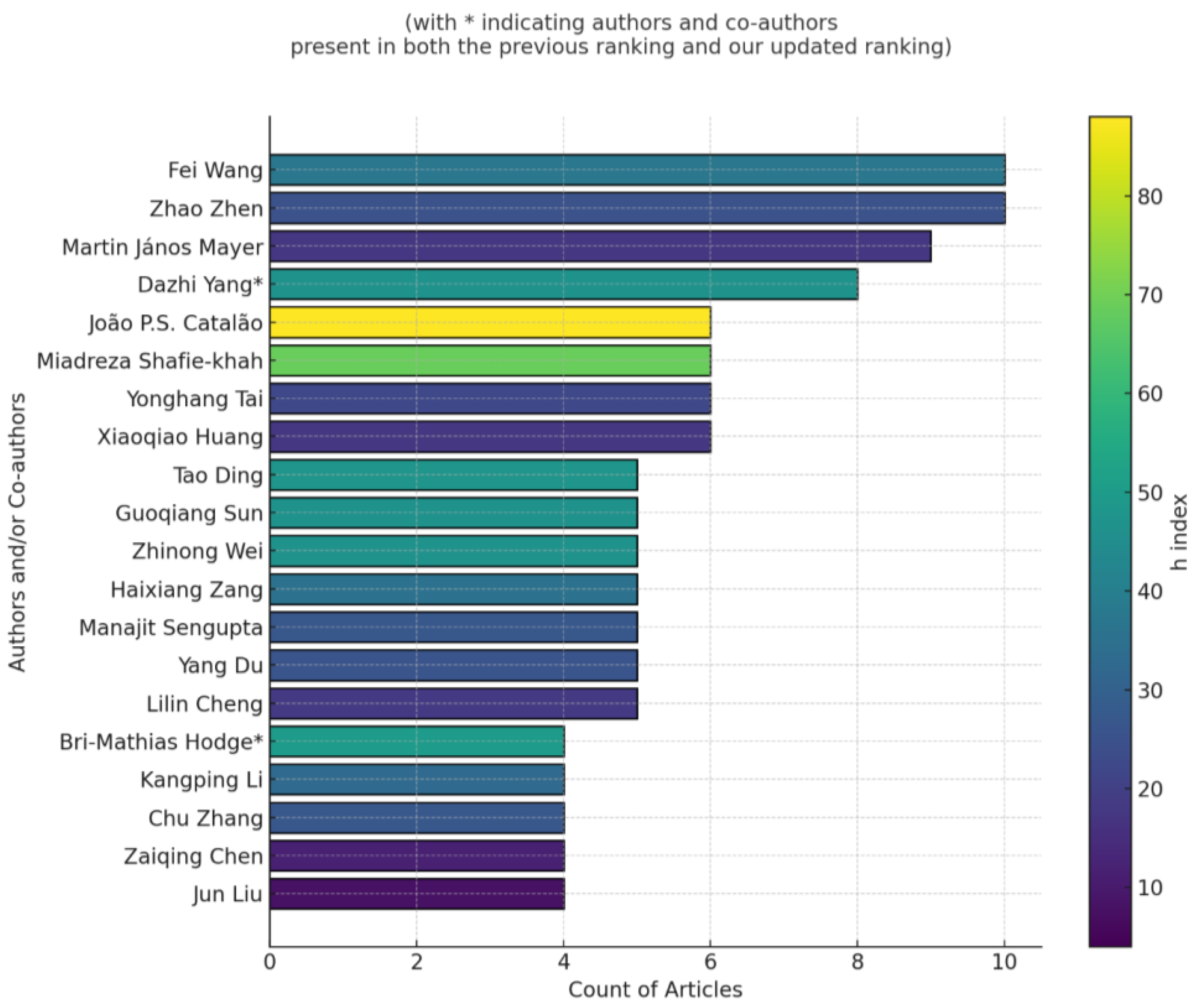
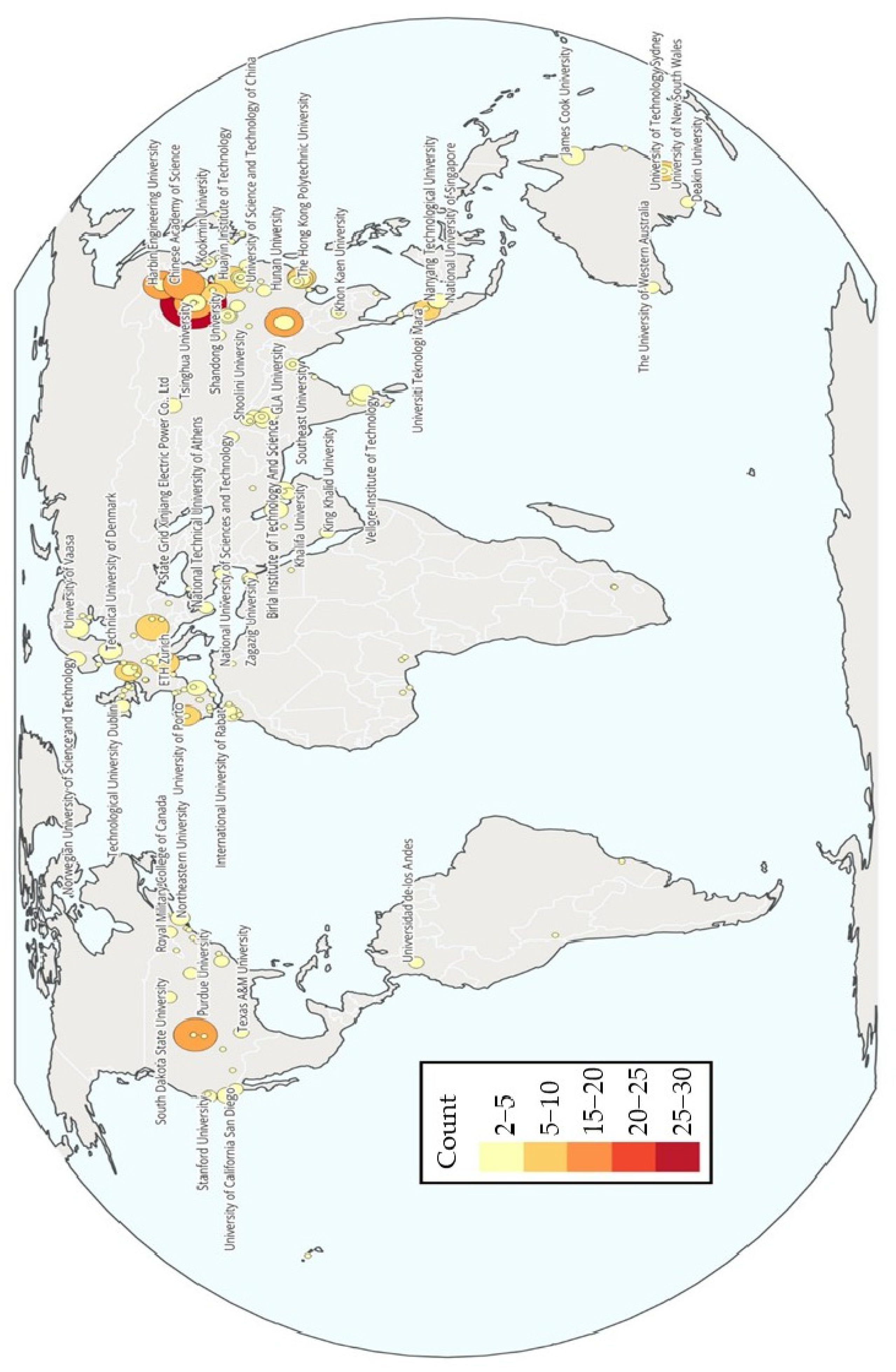
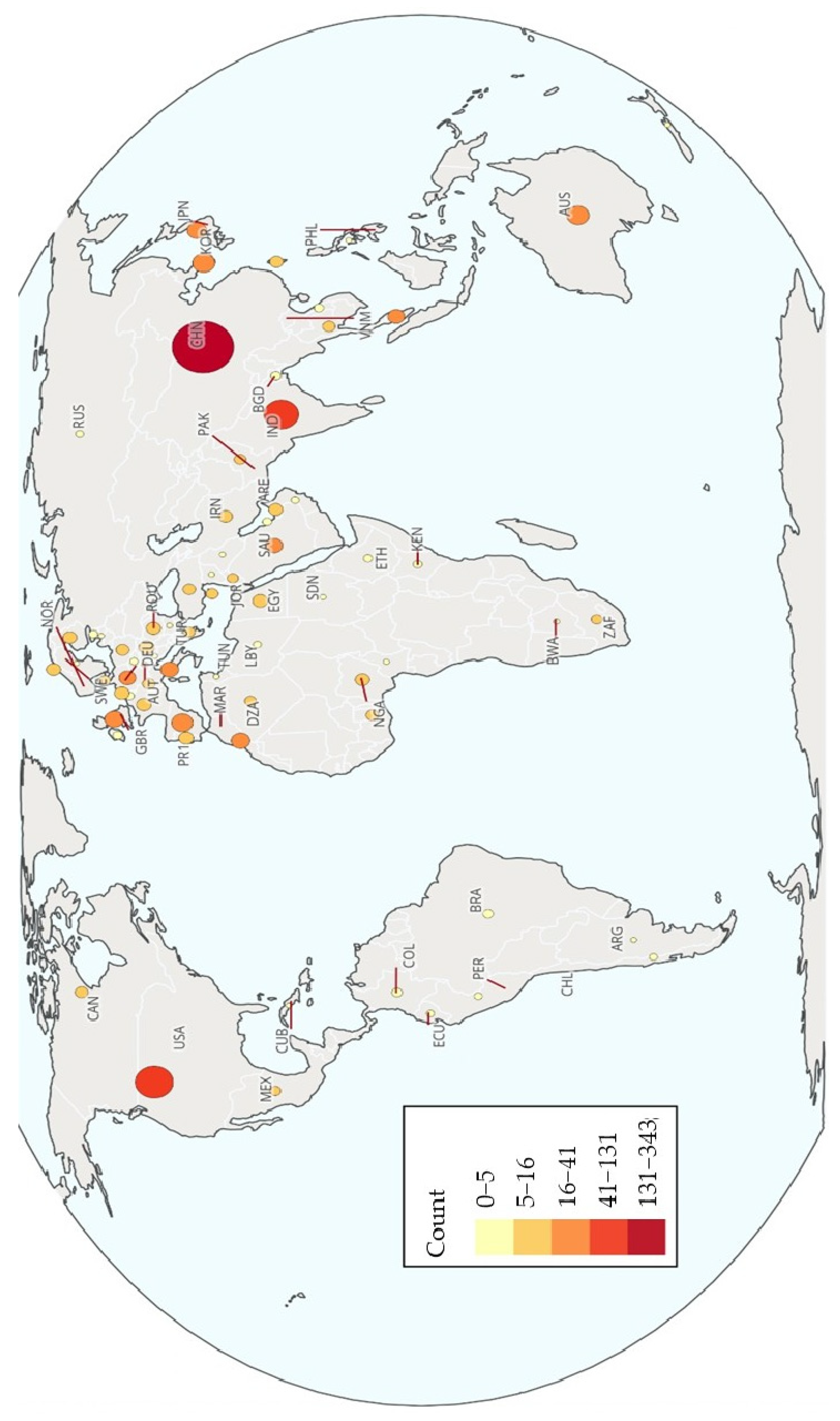
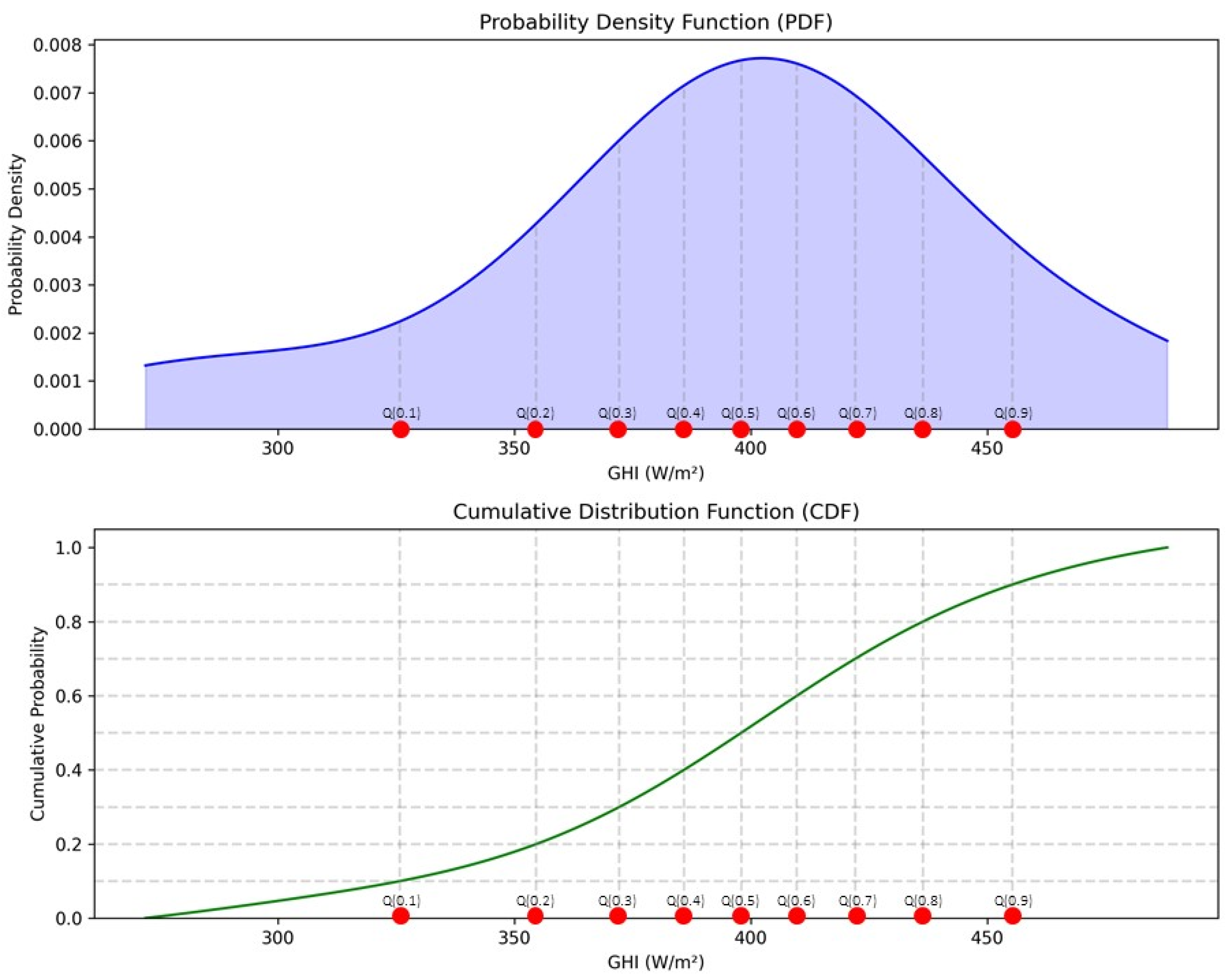
| Database Name | Number of Articles |
|---|---|
| ScienceDirect | 276 |
| IEEE Xplore Digital Library | 129 |
| MDPI | 42 |
| SpringerLink | 30 |
| Wiley Online Library | 23 |
| Total | 500 |
| Journals | Previous Ranking (Out of 20) [6] | Updated Ranking (Out of 20) | Δ Rank |
|---|---|---|---|
| Solar Energy | 1 | 3 | −2 |
| Renewable Energy | 2 | 4 | −2 |
| Renewable and Sustainable Energy Reviews | 3 | 11 | −8 |
| Energy Conversion and Management | 4 | 8 | −4 |
| Energy | 5 | 6 | −1 |
| Applied Energy | 6 | 7 | −1 |
| IEEE Transactions on Sustainable Energy | 7 | 5 | +2 |
| Energies | 10 | 9 | +1 |
| IEEE Transactions on Power Systems | 15 | 15 | 0 |
| Electric Power Systems Research | 16 | 13 | +3 |
| Geostationary Meteorological Satellites Families | Abbrev. | Observation Frequency | Operator |
|---|---|---|---|
| Meteosat Second Generation | MSG | 15 min | European Organization for the Exploitation of Meteorological Satellites (EUMETSAT) |
| Geostationary Operational Environmental Satellite | GOES | 15 min | National Oceanic and Atmospheric Administration (NOAA), USA |
| Himawari | - | 10 min | Japan Meteorological Agency (JMA) |
| NWP Models | Abbrev. | Global or Mesoscale | Forecast Horizon & Spatial Horizontal Resolution | Operator |
|---|---|---|---|---|
| Global Forecast System | GFS | Global | Forecast Horizon: 16 days Spatial Horizontal Resolution: 28 km, but decreases to 70 km for forecasts extending from one to two weeks | National Centers for Environmental Information (NCEI), USA |
| High-Resolution Forecast System | HRES | Global | Spatial Horizontal Resolution: 10 days Spatial Resolution: 9 km | European Centre for Medium-Range Weather Forecasts (ECMWF) |
| Ensemble Prediction System | EPS | Global | Forecast Horizon: 15 days Spatial Horizontal Resolution: 16 km | European Centre for Medium-Range Weather Forecasts (ECMWF) |
| North American Mesoscale | NAM | Mesoscale—Continental United States of America | Forecast Horizon: 3.5 days Spatial Horizontal Resolution: 12 km | National Centers for Environmental Information (NCEI), USA |
| Application of Research to Operations at Mesoscale | AROME | Mesoscale—France and neighboring countries | Forecast Horizon: 2 days Spatial Horizontal Resolution: 2.5 km (1.3 km within France) | Météo-France |
| Weather Research and Forecasting | WRF | Mesoscale—Can be configured to cover any specific geographic area, ranging from local to regional scales. | Forecast Horizon: Depending on the configuration Spatial Horizontal Resolution: Depending on the configuration | National Center for Atmospheric Research (NCAR) and National Oceanic and Atmospheric Administration (NOAA), USA |
| Method Categories | Previous Ranking (2012–2017) [6] | Updated Ranking (Out of 5) |
|---|---|---|
| Traditional Time Series Methods | 1 | 4 |
| Neural Networks | 2 | 2 |
| Standard Machine Learning Techniques | 3 | 3 |
| Regression | 4 | 5 |
| Deep Learning | 5 | 1 |
| Category | Error Metrics | Abbrev. | Count | Example of Application in Literature |
|---|---|---|---|---|
| Probabilistic Forecast | Continuous Ranked Probability Score | CRPS | 15 | [105] |
| Prediction Interval Coverage Probability | PICP | 9 | [54] | |
| Prediction Interval Normalized Average Width | PINAW | 7 | [106] | |
| Brier Score | BS | 6 | [107] | |
| Coverage Width-based Criterion | CWC | 5 | [108] | |
| Deterministic Forecast | Root Mean Square Error | RMSE | 142 | [109] |
| Mean Absolute Error | MAE | 113 | [16] | |
| Normalized Root Mean Square Error | nRMSE | 49 | [110] | |
| Mean Absolute Percentage Error | MAPE | 46 | [111] | |
| Mean Squared Error | MSE | 46 | [112] | |
| Mean Bias Error | MBE | 23 | [113] | |
| Normalized Mean Absolute Error | nMAE | 17 | [114] | |
| Relative Root Mean Square Error | rRMSE | 11 | [115] | |
| Normalized Mean Bias Error | nMBE | 6 | [116] | |
| Mean Average Deviation | MAD | 5 | [117] | |
| Mean Relative Error | MRE | 5 | [118] |
Disclaimer/Publisher’s Note: The statements, opinions and data contained in all publications are solely those of the individual author(s) and contributor(s) and not of MDPI and/or the editor(s). MDPI and/or the editor(s) disclaim responsibility for any injury to people or property resulting from any ideas, methods, instructions or products referred to in the content. |
© 2025 by the authors. Licensee MDPI, Basel, Switzerland. This article is an open access article distributed under the terms and conditions of the Creative Commons Attribution (CC BY) license (https://creativecommons.org/licenses/by/4.0/).
Share and Cite
Asloune, M.; Notton, G.; Voyant, C. From Trends to Insights: A Text Mining Analysis of Solar Energy Forecasting (2017–2023). Energies 2025, 18, 5231. https://doi.org/10.3390/en18195231
Asloune M, Notton G, Voyant C. From Trends to Insights: A Text Mining Analysis of Solar Energy Forecasting (2017–2023). Energies. 2025; 18(19):5231. https://doi.org/10.3390/en18195231
Chicago/Turabian StyleAsloune, Mohammed, Gilles Notton, and Cyril Voyant. 2025. "From Trends to Insights: A Text Mining Analysis of Solar Energy Forecasting (2017–2023)" Energies 18, no. 19: 5231. https://doi.org/10.3390/en18195231
APA StyleAsloune, M., Notton, G., & Voyant, C. (2025). From Trends to Insights: A Text Mining Analysis of Solar Energy Forecasting (2017–2023). Energies, 18(19), 5231. https://doi.org/10.3390/en18195231








